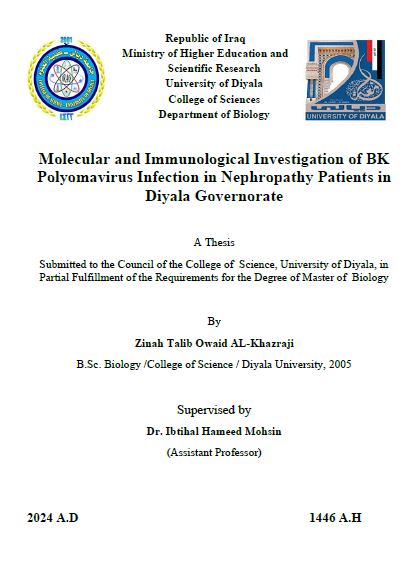المستخلص
Nephropathy is described as problems with the structure or function of the kidney, regardless of the underlying cause or specific clinical manifestation. Often begins with primary kidney damage and advances through the phases to kidney failure. Kidney loss is a potentially lethal illness since the kidneys’ principal and most evident tasks are to eliminate waste products and manage the body’s water and acid-base balance. There are many factors causing nephropathy, one of these factors are BK polyomavirus, BK virus-associated nephropathy (BKVAN) is an important reason for missing grafts in kidney transplants. The current study was conducted in Diyala province, Iraq, from October 2023 to March 2024, at Baqubah Teaching Hospital, after obtaining approval from the Scientific Committee for Diyala Health department according to an administrative order numbered (51043) dated 25/09/2023.
This study sought to determine the separation of antiBK Polyomavirus (antiBKV IgG, IgM), estimation of the cytotoxic T lymphocyte (CD+8) levels’ concentration in patients with nephropathy in Diyala Governorate – Iraq. Molecular diagnosis of BKVP1 gene and their genotype via RT-PCR, Identification of BK Polyomavirus gene regions using molecular diagnostic methods such as noncoding control region (NCCR), Early coding areas transcribe the tumorigenic proteins (LT- Ag), and application of bioinformatics techniques to assemble sequencing data, in order to create phylogenic trees.
From blood of 130 patients with nephropathy and 40 healthy blood donors include venous blood (serum and plasma) from the patients after diagnoses in the Ibn Sina Dialysis Center, the Kidney and Urology Department affiliated with the Consulting Clinic, the Oncology Center and the Urology Clinic / Baqubah Teaching Hospital, and outpatient clinics specializing in kidneys and urinary tracts by Nephrologist.
All subjects undergo for serological testing using the enzyme-linked immunosorbent assay (ELISA) to detect the presence of antiBKV IgG, was positive in 98/130 (75.4%) of patients and only 5/40 (12.5%) in healthy, while antiBKV IgM was positive in 20 out of 130 (15.4%) of patients, and to estimation CD+8 T cell levels in the blood, which was 8.685 ± 2.458 in the positive IgM group, while it was 3.359 ± 1.096 in the negative BKV IgM. Mean urea level was elevated in the patients with positive BKV infection than in patients with the negative infection which was 157.9 ± 77.88 in patients with positive infection while it was 47.16 ±4.498 in the negative BKV IgM, creatinine mean very elevated with positive BKV infection group than negative group which was 6.939 ±1.662 in positive group and it was 3.820 ± 2.773 in negative.
Age group between 56-70 years was the highest group of positive BKV IgG, IgM, which was 37/98 (37.8% ) and 10/20 (50 % ) respectively, while the age >70 years was the lowest group of positive BKV IgG which was 13/98(13.2% ) and age group under forty years was the lowest group of positive BKV IgM.
Regarding sex, the male was the biggest group, then females were 60/98(61.2 %) and 16/20 (80 % ) in positive BKV IgG and IgM groups, respectively.
The renal failure patients were the highest group of positive IgG and IgM than other groups included in this study, which were 51/98 (52%), and 18/20 (90%) respectively. All the individuals in the positive IgG and IgM groups that had a history of kidney transplant (kidney T.) in all patient groups, were positive for BKV IgG and IgM, therefore it has a positive correlation with antiBKV (IgG, IgM), particularly with BKV IgM (R= 0.469**). The other diseases (diabetes, hepatitis B, C virus, and tumors) have a positive correlation with the antiBKV (IgM) of nephropathy patients (R= 0.513**).
Molecular detection of BK Polyomavirus via RT-PCR technique 8/20 positive for BKVP1gene. While the dominant genotypes in our study was the fourth genotype (IV) was the common type in patients with nephropathy in Diyala Governorate, whereas the first, second, and third genetic types were not present. Then the genetic regions were investigated, the noncoding control region (NCCR) gene responsible for replication and transcription of the virus, which was found in 2/8 of sample testing, and the large Early coding areas transcribe the tumorigenic proteins (LT- Ag) gene, which is related to the occurrence of tumors, were also investigated, and there was no positive results in the samples that were tested.
Following chose two samples with the highest purity, to explore the genetic polymorphisms (sequencing) of two BK polyomavirus samples, the genetic polymorphisms is found that the investigated samples incorporated within the clade of serovar IV in close phylogenetic positions to many strains isolated from Kuwait with no phylogenetic distances among them. Thus, the observed viral variants might originate from the Kuwaiti isolates that belong to serovar IV. Phylogenetic analysis revealed that the VP1-based viral samples of genotypes IV, II, and III, are respectively descended from serovar I due to this group’s proximity to the tree’s roots. These variations’ translation to amino acid residues revealed, the alignment results of the 230 bp samples revealing the detection of no nucleic acid variations in comparison with the referring sequences of the BK polyomavirus sequences.
The current study concluded, potently indicated the role of BKV occurrence in nephropathy especially in kidney failure patients undergoing dialysis; this suggests that dialysis is a strong risk factor for BKV infection in such patients. CD+8 T Cells level were elevated with BKV occurrence therefore, they have an essential role in suppressing and managing the virus. Based on the phylogenetic positioning of clinical samples examined relative to Kuwaiti viral samples of serovar IV, VP1 amplicons demonstrated highly sensitive differentiation among the analyzed viral sequences. According to the study, BK polyomavirus-VP1 amplicons could serve as markers to differentiate between these pathogenic viral isolates. Therefore, this study emphasizes the importance of genetic variation in understanding the molecular epidemiology and evolutionary dynamics of BK polyomavirus, which may influence the evolutionary framework and geographical tracking of the virus.





